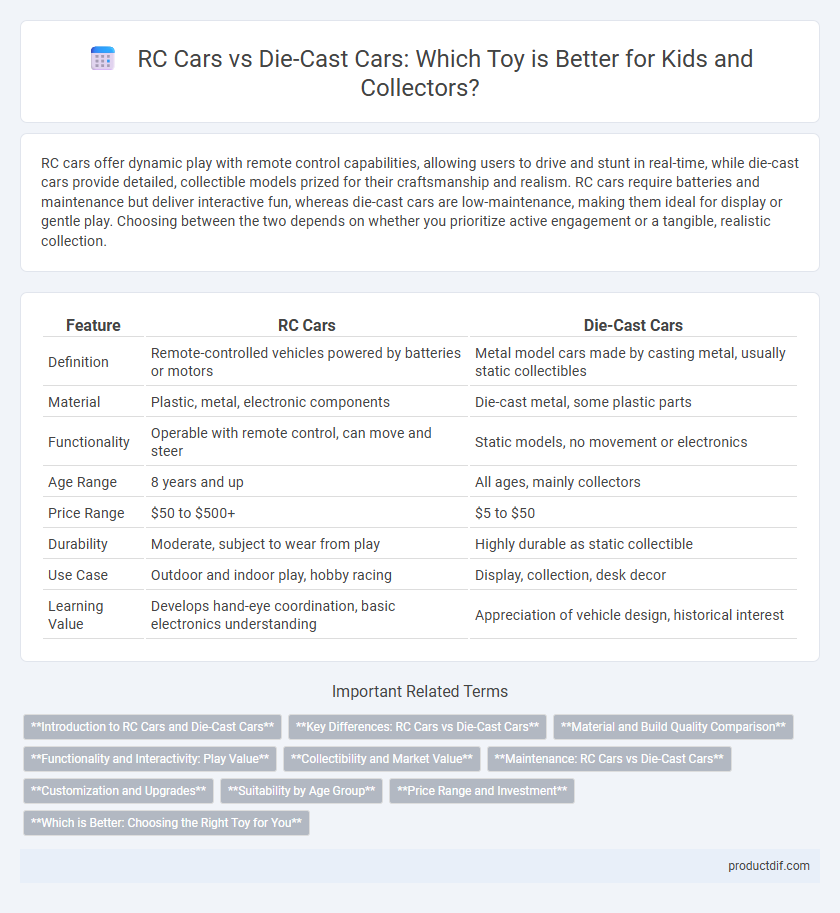RC cars offer dynamic play with remote control capabilities, allowing users to drive and stunt in real-time, while die-cast cars provide detailed, collectible models prized for their craftsmanship and realism. RC cars require batteries and maintenance but deliver interactive fun, whereas die-cast cars are low-maintenance, making them ideal for display or gentle play. Choosing between the two depends on whether you prioritize active engagement or a tangible, realistic collection.
Table of Comparison
| Feature | RC Cars | Die-Cast Cars |
|---|---|---|
| Definition | Remote-controlled vehicles powered by batteries or motors | Metal model cars made by casting metal, usually static collectibles |
| Material | Plastic, metal, electronic components | Die-cast metal, some plastic parts |
| Functionality | Operable with remote control, can move and steer | Static models, no movement or electronics |
| Age Range | 8 years and up | All ages, mainly collectors |
| Price Range | $50 to $500+ | $5 to $50 |
| Durability | Moderate, subject to wear from play | Highly durable as static collectible |
| Use Case | Outdoor and indoor play, hobby racing | Display, collection, desk decor |
| Learning Value | Develops hand-eye coordination, basic electronics understanding | Appreciation of vehicle design, historical interest |
Introduction to RC Cars and Die-Cast Cars
RC cars are remote-controlled vehicles powered by electric or nitro engines, offering dynamic play with realistic movement and speed control. Die-cast cars are meticulously crafted scale models made from metal alloys, celebrated for their detailed design and collector appeal. Both types of toys cater to enthusiasts, with RC cars emphasizing interactive racing experiences and die-cast cars focusing on display and craftsmanship.
Key Differences: RC Cars vs Die-Cast Cars
RC cars feature remote-controlled motors allowing for dynamic, real-time movement and interactive play, while die-cast cars are static models crafted from metal alloys mainly valued for display and collection. The complexity of RC cars includes batteries, motors, and electronic components, enhancing functionality but requiring maintenance, whereas die-cast cars emphasize detailed craftsmanship and realism without mechanical parts. RC cars appeal to enthusiasts seeking hands-on experiences and racing, while die-cast cars attract collectors focused on authenticity and scale modeling.
Material and Build Quality Comparison
RC cars are typically constructed using high-grade plastics and metals such as aluminum and steel to ensure durability and withstand the mechanical stresses of remote control operation. Die-cast cars prioritize detailed metal casting, often using zinc alloy, which provides a solid, heavyweight feel but limits flexibility and impact resistance. The build quality of RC cars emphasizes functionality and robust internal components, whereas die-cast cars focus on realistic aesthetics and collectible precision.
Functionality and Interactivity: Play Value
RC cars offer dynamic play value through remote-controlled movement and real-time interaction, enhancing engagement and motor skills development. Die-cast cars provide tactile experience and detailed craftsmanship, ideal for imaginative play and collecting. The functionality of RC cars surpasses static die-cast models, delivering an interactive and immersive experience.
Collectibility and Market Value
RC cars offer high collectibility due to their mechanical complexity and brand-specific rarity, often commanding premium prices among enthusiasts. Die-cast cars maintain strong market value through limited-edition releases and detailed craftsmanship, appealing to traditional collectors. Both types see fluctuating values influenced by condition, production year, and brand prestige.
Maintenance: RC Cars vs Die-Cast Cars
Maintenance of RC cars involves regular battery charging, motor cleaning, and occasional replacement of parts like tires and gears to ensure optimal performance. Die-cast cars require minimal upkeep, mainly dusting and careful handling to preserve paint and detail. RC cars demand more time and technical knowledge for upkeep compared to the low-maintenance nature of die-cast collectibles.
Customization and Upgrades
RC cars offer extensive customization and upgrades, including adjustable motors, battery packs, and programmable controllers, allowing enthusiasts to enhance speed, handling, and performance. Die-cast cars, while primarily collectible models with limited modification options, can be customized through paint jobs, decals, and minor structural alterations to improve aesthetics. The hands-on upgrade potential in RC cars makes them a preferred choice for hobbyists seeking dynamic, performance-driven customization.
Suitability by Age Group
RC cars are ideal for children aged 8 and above who enjoy interactive play, as they require fine motor skills and coordination to operate the remote controls effectively. Die-cast cars suit younger children, typically ages 3 and up, offering durability and simple handling for imaginative play without electronic components. Age-appropriate selection ensures safety and maximizes the developmental benefits of each toy type.
Price Range and Investment
RC cars typically have a higher price range, starting from $50 and reaching over $1,000 for advanced models, reflecting their electronic components and functionality. Die-cast cars generally cost between $10 and $100, making them more affordable for casual collectors and children. Investment potential favors die-cast cars for rare, limited editions that can appreciate in value, while RC cars usually depreciate due to wear and technological obsolescence.
Which is Better: Choosing the Right Toy for You
RC cars offer interactive play with remote control features and customizable speed, making them ideal for children seeking dynamic experiences, while die-cast cars provide detailed craftsmanship and collectibility appealing to enthusiasts and younger children who prefer display and imaginative play. Consider factors like age, interest in technology, and space availability when choosing, as RC cars require batteries and open areas for operation, whereas die-cast cars are compact and durable for everyday handling. Selecting the right toy depends on the balance between action-oriented entertainment and detailed aesthetic value.
RC cars vs die-cast cars Infographic

 productdif.com
productdif.com